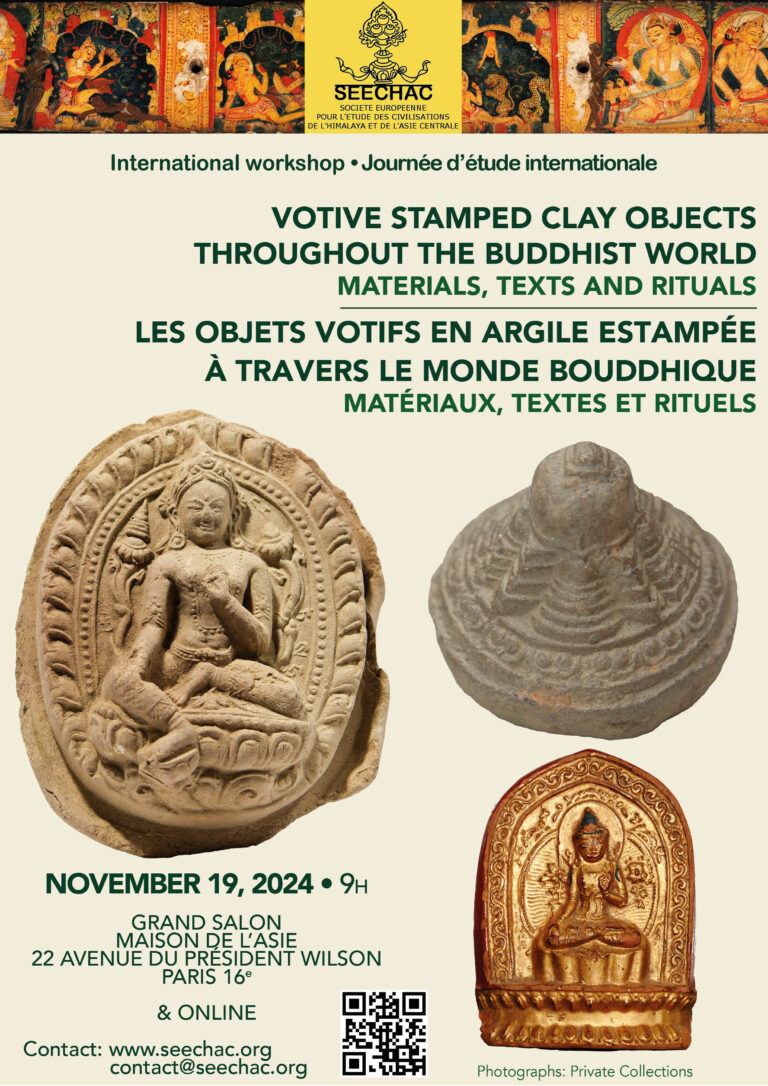Votive stamped clay objects throughout the Buddhist world: materials, texts and rituals
Since at least the Gupta period (3rd-6th century), impressions of Buddhist images have been made in clay, and often referred to as ‘seals’. This stamping practice, which spread with Buddhism throughout Asia, remains an important part of the religious life of certain communities today. These objects, in the form of monuments in the round or historiated tablets,are commonly known as tsha tsha in Tibetan. They are produced as part of various rituals (obtaining karmic merit, funeral rites) and in varying quantities, from a single piece to hundreds of thousands.This international study day will explore the material, textual and ritual dimensions of this ancient and protean Buddhist tradition.
Hybrid event. The Zoom connection link will be available on request from seechac@gmail.com.
Programme
09:15-09:45 Arrival of participants – Coffee & tea
09:45-10:00 Welcoming remarks by Charles Ramble, President of SEECHAC
10:00-10:30 Massimiliano A. Polichetti (Museo delle Civiltà, Rome)
The Giuseppe Tucci tsha tsha collection kept at the Museum of Civilizations in Rome (Zoom presentation)
10:30-11:00 Valérie Zaleski (Musée Guimet, Paris)
Votive tablets from China preserved in the Musée Guimet
11:00-11:30 Liying Kuo (EFEO, Paris)
The making of Shanyeni 善業泥, “Clay of Good Karma” in Central Tang China and the ceremony of Yinsha fo 印沙佛, “Stamped Sand Buddha” in Dunhuang
11:30-12:00 David C. Andolfatto (CRCAO, Paris)
Of clay and bones. Archaeometric analyses of tsha tshas from the collections of the musée du quai Branly-Jacques Chirac, Paris.
12:00-14:00 Lunch break
14:00-14:30 Erika Forte (Institute for Research in Humanities, Kyoto University)
Making sense of the sparse: What can we say about the production, circulation, and ritual use of clay votive plaques in the Tarim area?
14:30-15:00 Anna Filigenzi (University of Naples “L’Orientale” / ISMEO –The International Association for Mediterranean and Oriental Studies)
From models to models: Himalayan tsha tsha and their rhyzomic connections with Uḍḍiyāna
15:00-15:30 Christian Luczanits (SOAS, London)
Painted Tsatsa in Painted Chörten
15:30-16:00 Kunsang Namgyal Lama (INALCO, CESAH, Paris)
Considerations on ancient depictions of stūpas on tsha tshas
16:00-16:30 Closing remarks by Anna Filigenzi, Vice-president of SEECHAC
16:30 Aperitif

